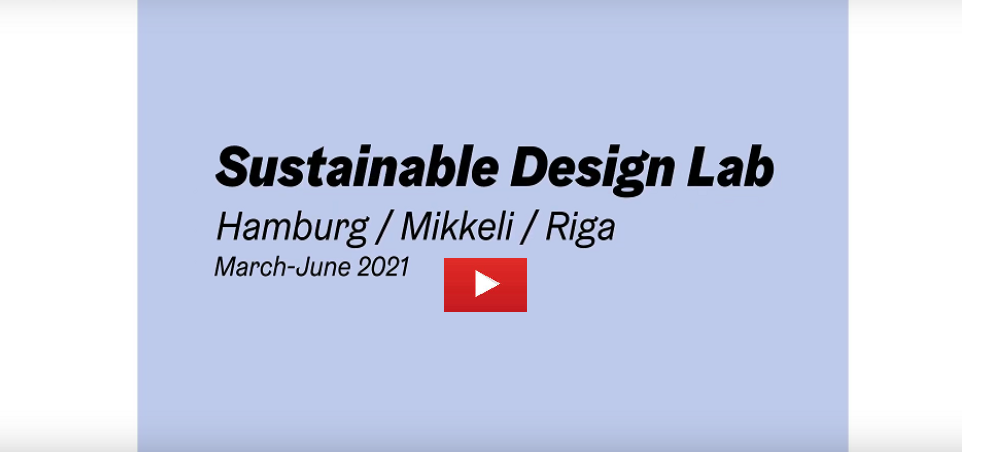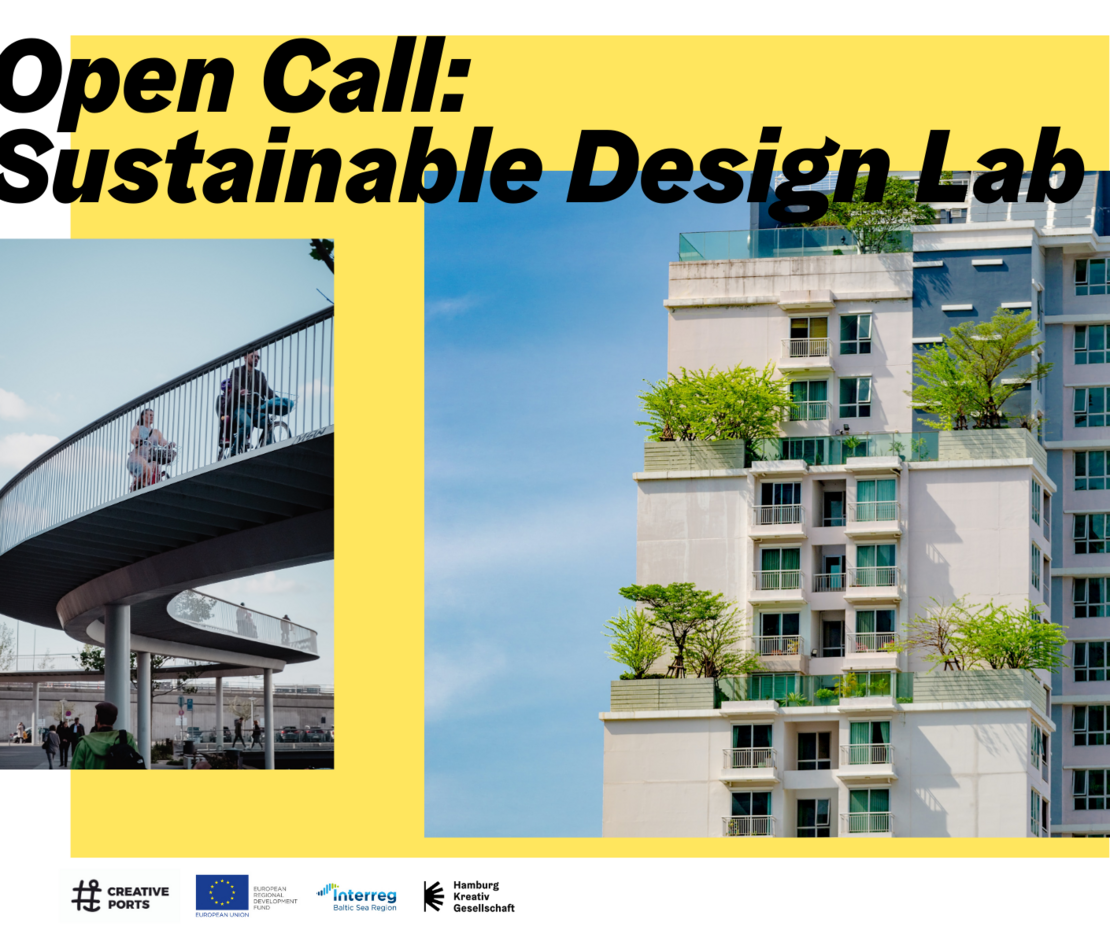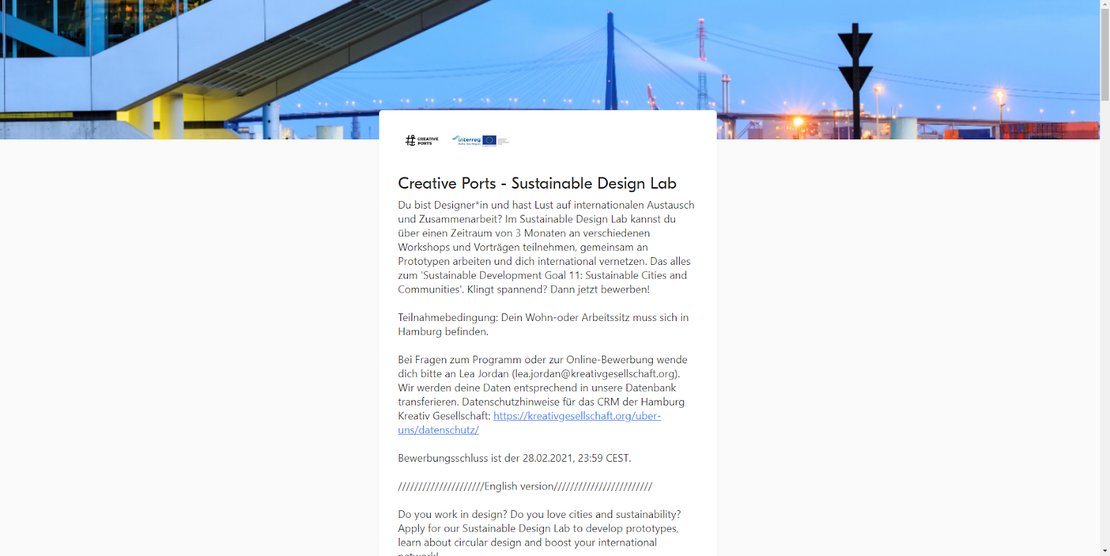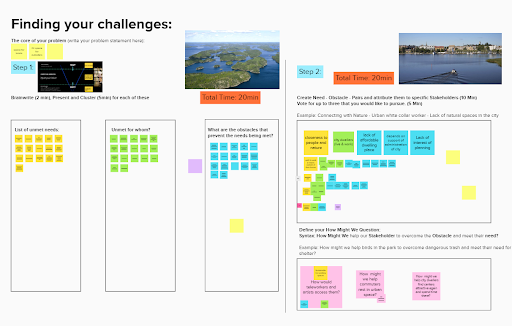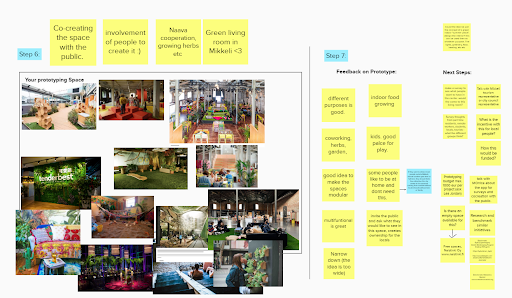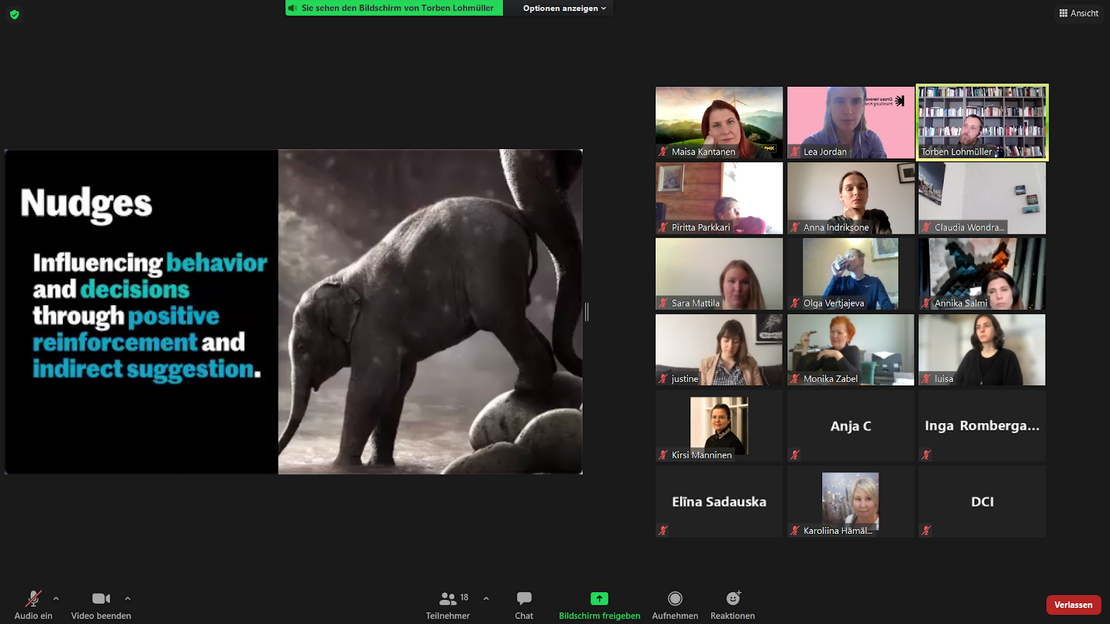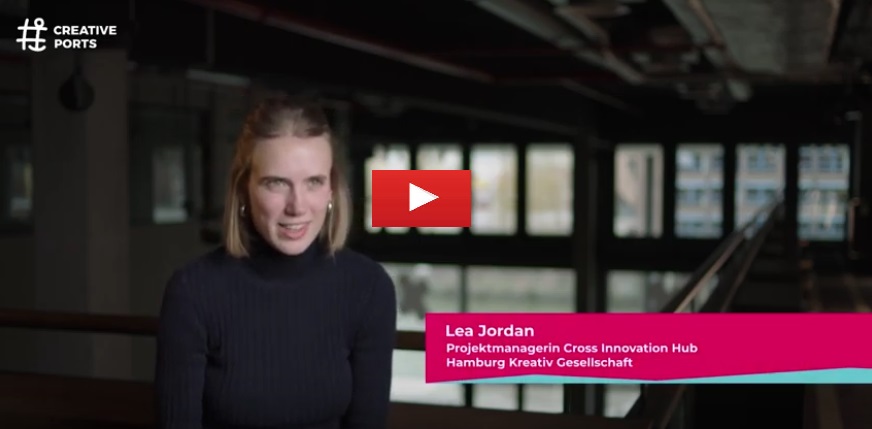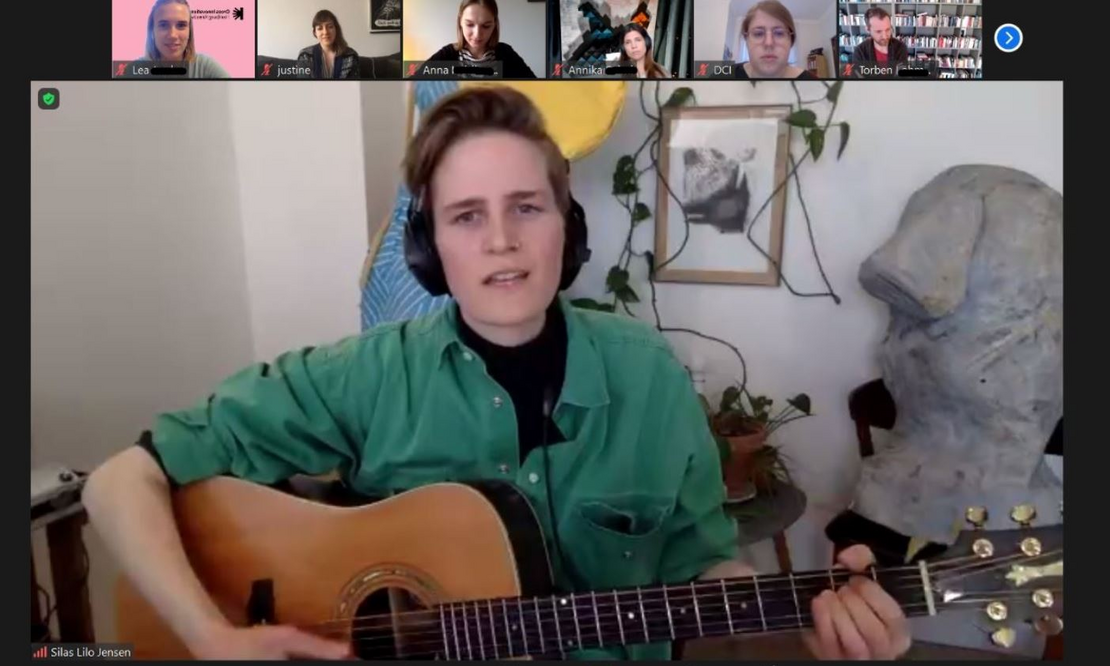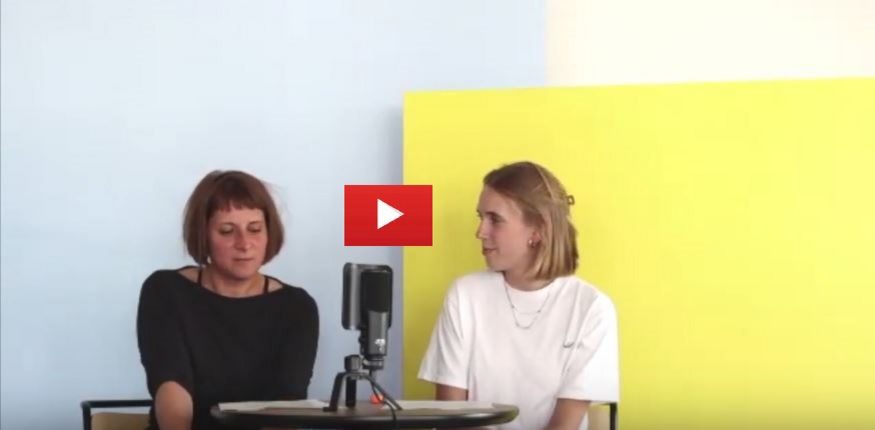ONLINE PROTOTYPING FOR SUSTAINABLE DESIGN
You would like to organize an international online prototyping lab about sustainable Design? This "how to guide" will help you plan and execute such a lab, learn about the do´s and dont´s and get an idea how to present the results in a final (online) event.
Hosting Partner: Hamburg Kreativ Gesellschaft
The learning outcomes for the module are:
- understand how to plan and execute an international digital prototyping lab for designers of different disciplines
- evaluate the challenges and opportunities related to the implementation of the case study Sustainable Design Lab
- apply the gained knowledge to develop your own idea for an international digital prototyping lab for designers of different disciplines
- create an international online prototyping lab about sustainable design
The learning module is based on the internationalisation tool – Sustainable Design Lab
A central aim of the Sustainable Design Lab is to encourage idea exchange in sustainable design among companies and individual designers. Furthermore, the aim was to demonstrate digital collaboration tools, benefit from working in an interdisciplinary and international peer group and educate designers to work colectivelly and digitally on design ideas and prototypes.
In addition to the aims above, the Sustainable Design Lab had a strong focus on using design for the development of sustainable cities through design and it therefore directly contributes to the international effort to reaching the UN Sustainable Development Goals (SDGs) of the UN.
Participating designers naturally expanded their network in the Baltic Sea Region by collaborating with different international designers, getting to know CCI support organisations, experts and local companies.
LEARNING MATERIALS
To plan an international prototyping lab digitally is quite the challenge - we experienced it ourselves. In this step, you can learn what to consider when planning an online prototyping lab and how to go about it.
1.1. General recommendations for the planning phase
- Multi-partner programmes require clear communication in terms of roles and responsibilities: make sure, everyone is aware of what is expected of him/her
- Make sure everyone is on the same page concerning goals and expected outputs
- If you plan to work with an external facilitator, be careful whom you choose. An experienced person in the field of (online) facilitation and facilitation of different groups and nationalities is an important asset.
it is also useful to involve him/her in the planning process from the beginning and discuss the concept of the programme, so it is clear what will be expected of him/her. - It is also very useful to onboard your participants right at the beginning of the project,, so that everyone knows what to expect from the programme and can prepare accordingly
- Make sure that all activities and communication strategies are planned prior to the start of the event - otherwise, it can become hectic during the time of the event.
- It is also important to clarify which extent of (media) presence you and your participants want. Have in mind that catching the attention of media is always tricky and might take some time, so calculate some possible extra effort.
1.2. Aims & Objectives
Our prototyping lab involved three partners, two time-zones, 15 participants, one facilitator and countless other stakeholders that joined throughout the process. In the beginning, it is important to set a common understanding of aims and objectives. Why are you doing what you’re doing? What do you expect of your partners and participants? What do you aim to achieve?
These aims and objectives might be different depending on the target group. Keep in mind whom you want to address, why and with which possible output.
We seperated the aims for our two main target groups: intermediaries and participants of the CCIs.
For the intermediaries:
- Learn how to organise an international prototyping lab (online)
- Foster collaboration and the exchange of ideas / influences between designers in the field of sustainable design on an international level (don´t stay local, especially in case of innovation)
- Offer a possibility to designers from different disciplines and countries to work together on diverse prototypes related to the topic of sustainable design
- Offer further education for designers through workshops, expert talks and training concerning different topics
- Foster the possibility of long term cooperation between designers on an international level
- Experiment with new digital tools for internationalization
For the participants:
- Learn how to tackle the challenge of sustainable design within an international group of designers
- Inspiration and exchange of experiences with designers from other disciplines and other countries
- Work together on different prototypes related to the topic of Sustainable Design with the group of designers of their own country and online with different local designers of the participating countries
- Possibility to learn about design trends in other BSR Countries, new technologies and innovations
- Gather more knowledge concerning the topic of Sustainable Design
- Develop prototypes that might be developed further even after the project ends
- Possible collaborations with other designers in the future on an international leve
- Experiment with new digital tools for internationalisation
1.3. Communication
In order to attract the right target audience, coherent communication across participating intermediaries is necessary. Therefore, it’s useful to provide the participating partners with the needed communication materials (information about the activity, call for applications, social media material, graphic material, videos, invitation to events etc.).
You can see an example of our social media communication on the right side.
Hosting an online prototyping lab is possible - but it requires the use of the right tools. There are plenty out there and these are just a few recommendations based on our own experience.
2.1. Airtable
We used airtable for the application phase of the project. It is a simple-to-navigate tool with which you can create application forms, collect results and share them with relevant partners. Alternatively, GoogleForms works pretty similar.
2.2. Miro & Mural
Mural or Miro are perfect tools for getting creative! We especially used these digital whiteboards for ideation and digital prototyping.
With those tools collaborative working is easy and in live time. There are a lot of premade templates you can use and you will find gratis versions and paid plans with more features. If the budget is low, the gratis versions still offer the basics you might need.
2.3. Zoom / Google meets / Microsoft teams
Zoom was our main meeting platform, which we used for workshops, keynotes and informal meetings (even concerts!). Breakout Sessions help to break up larger groups into smaller, more effective working groups. Facilitators and participants can share their screens and so are able to do digital presentations. Tools like Google meets and Microsoft teams work in a similar way.
- Digital facilitation is different from facilitation in physical spaces: make sure that your facilitator is experienced in hosting digital workshops and training sessions.
- assign one person to assist with possible technical difficulties of the participants or just to support the facilitator in its work.
- make time for informal activities and getting to know each other - this is even more important in the digital space! Have in mind that you bring together people from different countries who do not know each other beforehand. A good group dynamic is important for the teams to be working together effectively throughout the weeks and giving them the chance to get to know each other better as well on a personal level makes this interaction easier and more fluent.
3.2. Formats you can use throughout the program
Our programme aimed to create interactive, creative and efficient workshops. Although being only united digitally, we wanted to create the feeling of exploring cities together. Here you can find some examples of different formats we used:
Workshops
The Sustainable Design Lab spanned over a period of three months. Workshops usually took place on consecutive Fridays and Saturdays, with exception of informal meetings, which often took place in the evening during the weeks. Whilst we had day-long workshops, we would recommend to split up the workshop days into more frequent but shorter meetings (max 4 hours). Otherwise, it becomes difficult to stay creative and focussed in digital space. Participants tend to lose energy and concentration in longer digital sessions.
Pre-recorded videos:
Pre-recorded videos can make your workshop more interactive and vivid than powerpoint presentations. Plus, you can use them for communication purposes!
In our case, we used videos in order to visually present the cities that the different partner organisations are based in. How do the cities of the partner organisations look like? What are the urban challenges they are facing? The city presentations aimed to give the participants an idea of potential challenges to work on.
Digital Public Final Event
In order to bring attention to the ideas your participants have been working on and to further connect internationally, a public event and final presentation of the results of the lab can be useful.
It also drives the participants’ effort towards a common goal and creates anticipation for the end of the programme. We used Zoom Webinar to facilitate this live event and had the participants pitch their ideas in front of an audience.
Online concert
How to connect participants beyond learning and working together? How can you enjoy a glass of wine, beer or soda in an informal way if you are not in one place?
A live online concert can be a good way to create a special informal interaction and experience for the group as a whole and can be a great way to start or end a workshop day!
Your project has come to an end. What now? Learning from the experience of your participants and partners is essential so you can improve your project in the future. Here are some general recommendations for gathering feedback.
- Plan some time for discussion on how to continue the projects that resulted from the programme.
- Present to the participants how you as an intermediary can support the implementation / continuation of the projects.
- Ask for direct feedback from the participants and your partners or send out online evaluation forms to both groups. THis can be done via Google Forms or via Miro. There are plenty of templates available in Miro to do so.
When to do what:
| Task | Timeframe | |
| 1 | Develop concept for event / Specify the purpose of the project | 3 months prior to event |
| 2 | Find the right partners and finalise a partner agreement
| 3 months prior to event |
| 3 | Organise the set-up for the Pop-up Lab
| 3 months prior to event |
| 4 | Organize Side events / team building events
| 3 months prior to event |
| 5 | Publish an Open Call to choose the participants Important:
| 2 months prior to the event |
| 6 | Select the participating CCIs with the aid of a checklist of criterias developed by the involved partners.
| One month prior to event |
| 7 | Contact Lists: Make sure to have in the end a list of all participating CCI companies/designers and all participating partner organisations and their contacts. Especially important if there are staff changes in companies and institutions. | One month prior to event |
| 8 | If offline: Organise the travels/ accommodation/ transportation for the participants and of goods if necessary. | One month prior to event |
| 9 | Marketing
| From three weeks prior to the event on |
| 10 | Be sure that all the participants have the necessary information (links, addresses etc.) before the lab starts | One week prior to the event |
| 11 | Documentation:
| Before and during the lab |
| 12 | Evaluation:
| During and after the event |



